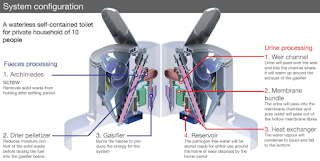REINVENT THE TOILET
Not so many days after the World Toilet Day (19 November), I have curiousingly come across a video in Youtube called 'Bill Gates Thinks These Toilets Could Change The World', which dates from November 2018, and which, taking into account the sanitation focus of this blog, I wish I had watched before... I find it weird that, having already talked about some of the latest sanitation projects aimed at developing countries such many African ones, this did not show up at any moment.
The Reinvent the Toilet Challenge was initiated in 2011 as a set of grants, awarded by the Bill and Melinda Gates Foundation, to researchers around the world for the development of innovative approaches to bring sustainable sanitation solutions to the developing countries. The initial idea arose when in 2009, founder of Microsoft Bill Gates posed the question: "is it possible to leapfrog the long-accepted “gold standard” of sanitation: flush toilets, sewers, and treatment plants?".
Although some people were skeptical about this, work with partners ended up in the development of a small-scale prototype to process faecal matter and biosolids from pit latrines (the most popular sanitation facility -see previous post) and other elements of the sewerage systems. Called Omni-Processor, this self-powered technology kills dangerous pathogens and finally converts the materials into clean water, electricity, fertilizer or other products with commercial value.
The idea of the Reinvented Toilet was the following step. The aim is to design a toilet that not only kills pathogens, but at the same time is self-contained and has no dependance on a connection to water or sewage lines (Grunge).
*
The Nano Membrane Toilet
One example that has received a successful reception is The Nano Membrane Toilet. It is being developed at Cranfield University, and after a survey in Kumasi, Ghana, it has shown a potential willingness of use of its product water for a wide range of purposes (Cruddas et al, 2015); so the preponderant hope is that the manufacturing cost decreases sufficiently as to spread affordability at a household level (Grunge).
How does it work?
Faeces and other biosolids are collected through a series of gears in motion, and deposited in a tank at the bottom (where odours are contained within an air-tight seal). When this occurs, as there is no water involved, a blade scrapes the bowl in order to clean it (Grunge). Then, they are collected again through an Archimedes screw (see picture), which enables drainage by gravity, and transferred to a section where they are divided and dried before introduction to a small gasifier where the material is burned (Cruddas et al, 2015). The screw can be powered through electricity but also through human endeavour (Hanak et al, 2016). The process, as emphasized by Dr. Alison Parker (Cranfield University, 2016), not only generates harmless ash (which is collected by the user once a week), but also produces the energy required in other steps such as the membrane filtering which turns urine into safe water, explained below.
In regards to the liquids, they are extracted from the tank and filtered through a dense membrane bundling, inducing pervaporation (a process that only allows water and ammonia in a partially vaporized state, but not dissolved contaminants, to get through). Later on the vapor is condensed and ammonia is removed in a column with ion-exchange beads which absorb it. The resulting water is collected in a reservoir which is accessible to the collection by the user (for re-use for watering crops or watering livestock, usually) (Cruddas et al, 2015).
Figure 1. Detailed scheme of the main sections of the Nano Membrane Toilet (Cranfield University, 2016).
*
The Reinvent the Toilet Challenge Expo has been held several time since its foundation, the last one having taken place in Beijing, in November 2018 (you can know more by clicking here). The particular aims of the project are, as suggested by the example shown above, to create a toilet that fulfils:
- Removal of germs from human waste, through a process that permits to recover energy, clean water and nutrients.
- Operation without need of connections to water, sewerage or electrical lines, elements which are lacking or scarce in many developing regions.
- Daily cost under $0.05 cents/user.
- Promotion of sustainability and financially profitable businesses in the developing regions where it is implemented.
- Attraction and acceptance from a wide audience.
The toilet of tomorrow could "turn crap into valuable resources", not only in the African countries that are approached in this blog, but in many developing regions. Further studies and assessments are needed to evaluate both affordability and viability, as well as other possible implications. Click here to watch the video posted by the GatesFoundation about Reinvent the Toilet.


Perhaps we can put it at the houses, administration building and hotels. It's a big idea for make the wolrd 'd better
ReplyDeleteYes! That is a good point. In fact this solution has been implemented in different kinds of contexts and cities, not only in Africa but also in Asia or Europe (Sweden for instance), and it has turned out to be quite successful. However, some improvements regarding cleanliness of the system or the management of the products need to be done. Hopefully, if the popularization of the Dry-Toilets brings a decrease in cost, this solution could be suitable for both small, developing-communities (maybe even at a household level) as well as for buildings belonging to the services sector.
Delete